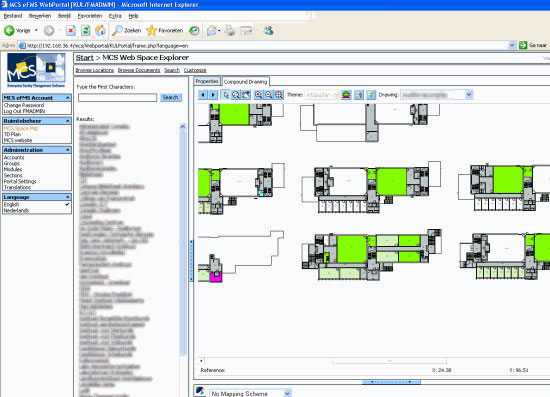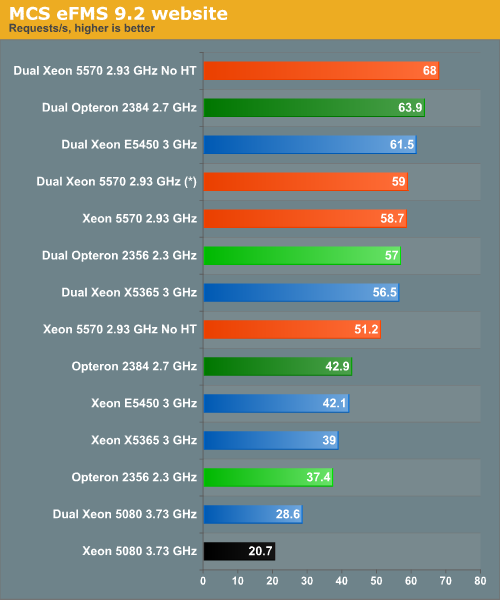The Best Server CPUs part 2: the Intel "Nehalem" Xeon X5570
by Johan De Gelas on March 30, 2009 3:00 PM EST- Posted in
- IT Computing
| Website: MCS eFMS (Windows 2003 32-bit EE) | |
| Operating System | Windows 2003 R2 - 32-bit |
| Software | MCS eFMS 9.2 |
| Benchmark software | vApus + real world "MCS" PHP site |
| Typical error margin | 1-2% |
One very interesting and processing intensive application that we encountered was the modular MCS Enterprise Facility Management Software (MCS eFMS), developed by MCS. The objective of eFMS is to integrate the management of space usage (buildings), assets and equipment (such as furniture, beamers etc.), cabling infrastructure, and others while keeping track of costs. MCS eFMS stores all information in a central Oracle database.

MCS eFMS integrates space management, room reservations and much more…
What makes the application interesting to us as IT researchers is the integration of three key technologies. First, it uses a web-based front end that integrates CAD drawings and gets its information from a rather complex, ERP-like Oracle database. It provides building overview trees of all rooms available and their reservations in a certain building. Finally, it allows users to drill down using the CAD drawing to get more detail. MCS eFMS is one of the most demanding web applications we have encountered so far. MCS eFMS uses the following software:
- Microsoft IIS 6.0 (Windows 2003 Server Standard Edition R2)
- PHP 4.4.0
- FastCGI
- Oracle 9.2
Large international companies such as Siemens, Ernst & Young, and Startpeople use MCS eFMS daily, which makes testing this application even more attractive. We tested with both single CPU and dual CPU configurations.

(*) CPU load was at 50-55%.
For once, the Opteron stays in the slipstream of the Xeon X5570. If you look at the single CPU results, you can see that something went wrong: the Xeon X5570 with HT enabled is about 37% faster than the Opteron at 2.7GHz, but once we add a second Xeon X5570, the website refuses to perform better. Without Hyper-Threading, adding four more cores leads to a 32% performance increase from 51.2 responses per second to 68 responses per second. This seems to be something PHP related, as there are too few PHP threads to actually absorb CPU power. The result is that the dual Xeon X5570 with Hyper-Threading enabled is only loaded at 50%-55%, clearly indicating that the PHP site is not making use of the 16 logical cores. Windows 2003 R2 does not seem to schedule its threads optimally in that case.
This real world test shows that not all applications are capable of scaling up easily. We know from previous tests that this application scales out when you use load balancing. If we only look at the single CPU performance, which is quite common in the website market, we can conclude that Xeon X5570 is about 37% faster than its best competitor and 39% faster than its predecessor (Xeon 54xx). At that point both CPUs are running at 80 to 100% CPU load. You would almost be disappointed after all the spectacular performance numbers that the latest Xeon produced, but a 37% performance advantage is still very impressive.










44 Comments
View All Comments
Veteran - Wednesday, April 1, 2009 - link
I didn't mean to offend you, because i can imagine how much time it takes to test hardware properly. And i personally think that OLTP/OLAP testing is very innovative and needed. Because otherwise people would have no idea what to buy for servers. You cannot let you server purchase be influenced with meaningless (for servers) simple benchmarks like 3D 2006/Vantage/FPS test etc.You guys always are doing a great a job at testing any piece of hardware, but it is just feeling to much biased towards Intel. For example, at the last page of this review you get a link to Intel resource Center (in the same place as the next button). If you have things like that, you are not (trying to be) objective IMO.
JohanAnandtech - Wednesday, April 1, 2009 - link
Thank you for clarifying in a very constructive way."the last page of this review you get a link to Intel resource Center"
I can't say I am happy with that link as it creates the wrong impression. But the deal is: editors don't involve in ad management, ad sales people don't get involved when it comes to content.
So all I can say is to judge our content, not our ads. And like I said, it didn't stop us from claiming that Shanghai was by far the best server CPU a few months ago. And that conclusion was not on many sites.
Veteran - Wednesday, April 1, 2009 - link
Thanks for clarrifying this matter.But ad sales people should know this creates the wrong impression. A review site (for me at least) is all about objectivity and credibility. When you place a link to Intel's Resource Center at the end of every review, it feels weird. People on forums already call Anandtech, Inteltech. And i don't think this is what you guys want.
I always liked Anandtech since when I was a kid, and I still do. You guys always have one of the most in-depth reviews (especially on the very technical side) and I like that. But you guys are gaining some very negative publicity on the net.
BaronMatrix - Tuesday, March 31, 2009 - link
Unfortunately, I don't buy from or recommend criminals.carniver - Wednesday, April 1, 2009 - link
AMDZone is the biggest joke on the internet. I just went there to see how the zealots like abinstein are still doing their damage control; just like before he went on rambling how the Penryn is still weak against Shanghai, and the old and tired excuses like how if people all bought AMD they can drop in upgrades etc etc. ZootyGray...he's the biggest joke on AMDZone. None of them had the mental capacity to accept AMD has been DEFEATED, which is disappointing but funny to say the leastduploxxx - Wednesday, April 1, 2009 - link
It's not just AMDZone, you are just the opposite. Its like in Woodcrest and conroe times, it's not because the high-end cpu is the best of all that the rest of the available cpu's in the line is by default better. It's all about price performance ratio. Like many who were buying the low-end and think they had bought the better system, well wrong bet.As mentioned before, why not test the mid range that is where the sales will be. Time to test 5520-5530 against 2380-82 after all those have the same price.
carniver - Wednesday, April 1, 2009 - link
Your argument is valid, however, it just so happens that for low end 1S systems the Penryns are doing just fine against the Shanghais, for higher end 2S systems they used to be limited by memory bandwidth and AMD pulls ahead. No more is this the case, Intel now beats AMD in their own territory.CHADBOGA - Tuesday, March 31, 2009 - link
You probably also can't afford to buy a computer, so I doubt that Intel will be too concerned with your AMDZone insanity. LOL!!!!smilingcrow - Tuesday, March 31, 2009 - link
Those grapes you are chewing on sure sound sour to me. Try listening to a few tracks by The Fun Loving Criminals to help take away the bad taste.cjcoats - Tuesday, March 31, 2009 - link
There's more to HPC applications than you indicate: environmental modeling apps, particularly, tend to be dominated by memory access patterns rather than by I/O or pure computation. Give me a ring if you'd like some help with that -- I'm local for you, in fact...